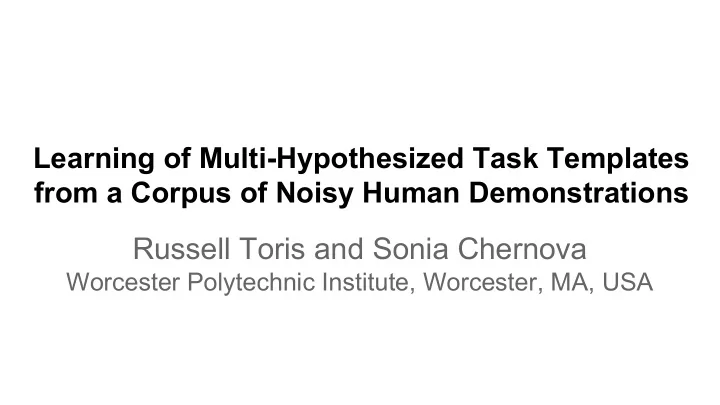

Learning of Multi-Hypothesized Task Templates from a Corpus of Noisy Human Demonstrations Russell Toris and Sonia Chernova Worcester Polytechnic Institute, Worcester, MA, USA
Motivation ● Traditional LfD focuses on teaching sequences ○ Trajectory learning ○ Keyframe learning ● Pick-and-place tasks concerned with end-state ○ Pack the items in the box ○ Put away the pallet ○ ... ● What’s missing: plausible goal states
The Problem ● How can we learn goal states based on high-level task descriptions? ● Different interpretations lead to different goal states
Challenges ● Multiple plausible goal states possible ● Learning should be done in an unsupervised manner ● Frame of reference unknown ● Requires large training set ○ Crowdsourcing ○ Noisy or malicious data
Methodology ● Data Collection ○ Raw placement locations of items per task ● Transformation ○ Autonomously extract features and eliminate irrelevant ones ● Model Training ○ Training templates (states) from transformed data
The Interactive World ● Browser based ● Micro-task markets ● Intuitive interface
Domain Surfaces Points of Interest (POIs) World Items
Data Collection “Your job is to place the given object in an appropriate location in the house.”
Data Transformation Cup in Table Space Plate in Counter Space Spoon in Plate Space ... Fork in Plate Space Plate in Table Space
Model Training ● Each transformed dataset becomes potential model λ ∈ Λ ● Search for and rank dense clusters
Tests and Verification Single Item Placement Multi-Item Random Multi-Item Template
Conclusion & Future Work ● Verified on a series of tasks ● Test in manufacturing and industrial domains ● Creates a base knowledge base ● Room for further, local expert user collaboration ● Modify models to personalize the template ○ Human-in-the-loop
Q&A
Recommend
More recommend